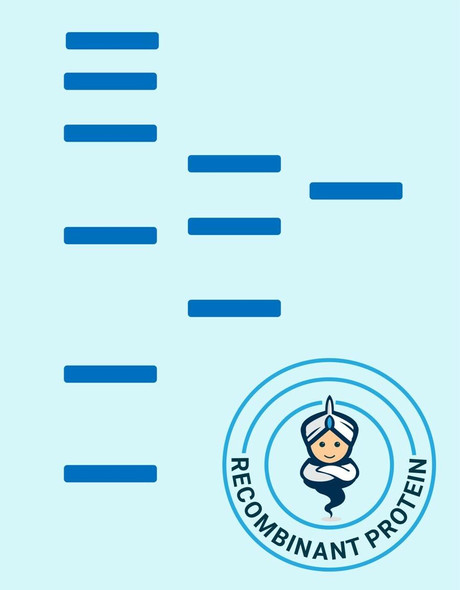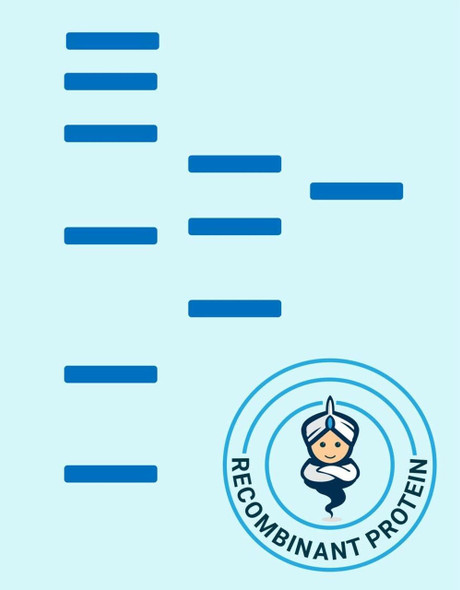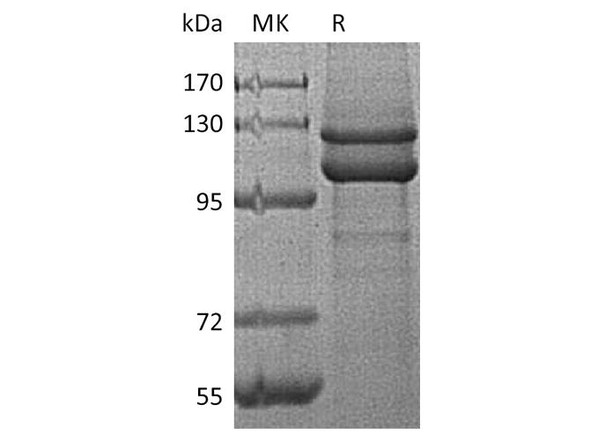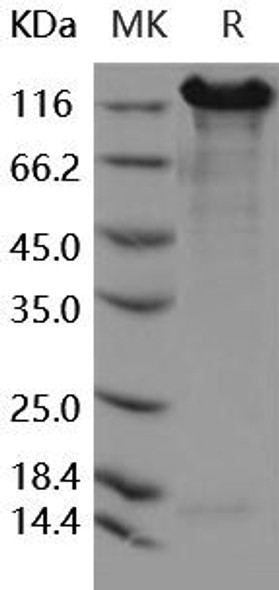Description
| Product Name: | Human CDH1 Recombinant Protein |
| Product Code: | RPPB3126 |
| Size: | 10µg |
| Species: | Human |
| Target: | CDH1 |
| Synonyms: | Cadherin 1, Type 1, E-Cadherin, Cadherin 1, Type 1,E-Cadherin (Epithelial), Epithelial Cadherin, CAM 120/80, Uvomorulin, CDHE, UVO,Calcium-Dependent Adhesion Protein, Epithelial, Cadherin 1, E-Cadherin(Epithelial), Cell-CAM 120/80, CD324 Antigen, Arc-1, CD324, ECAD, LCAM, Cadherin-1. |
| Source: | Sf9 Insect cells |
| Physical Appearance: | Sterile Filtered colorless solution. |
| Formulation: | CDH1 protein solution (0.5mg/ml) contains PhosphateBuffered Saline (pH 7.4) and 10% glycerol. |
| Stability: | Store at 4°C if entire vial will be used within 2-4 weeks. Store, frozen at -20°C for longer periods of time. For long term storage it is recommended to add a carrier protein (0.1% HSA or BSA).Avoid multiple freeze-thaw cycles. |
| Purity: | Greater than 90% as determined by SDS-PAGE. |
| Amino Acid Sequence: | EPEPCHPGFD AESYTFTVPR RHLERGRVLG RVNFEDCTGR QRTAYFSLDTRFKVGTDGVI TVKRPLRFHN PQIHFLVYAW DSTYRKFSTK VTLNTVGHHH RPPPHQASVS GIQAELLTFPNSSPGLRRQK RDWVIPPISC PENEKGPFPK NLVQIKSNKD KEGKVFYSIT GQGADTPPVGVFIIERETGW LKVTEPLDRE RIATYTLFSH AVSSNGNAVE DPMEILITVTDQNDNKPEFT QEVFKGSVME GALPGTSVME VTATDADDDV NTYNAAIAYT ILSQDPELPD KNMFTINRNTGVISVVTTGL DRESFPTYTL VVQAADLQGE GLSTTATAVI TVTDTNDNPP IFNPTTYKGQVPENEANVVI TTLKVTDADA PNTPAWEAVY TILNDDGGQF VVTTNPVNNDGILKTAKGLD FEAKQQYILH VAVTNVVPFE VSLTTSTATV TVDVLDVNEA PIFVPPEKRV EVSEDFGVGQEITSYTAQEP DTFMEQKITY RIWRDTANWL EINPDTGAIS TRAELDREDF EHVKNSTYTALIIATDNGSP VATGTGTLLLILSDVNDNAP IPEPRTIFFC ERNPKPQVIN IIDADLPPNT SPFTAELTHG ASANWTIQYN DPTQESIILK PKMALEVGDYKINLKLMDNQ NKDQVTTLEV SVCDCEGAAG VCRKAQPVEA GLQIPALEHH HHHH |
E-cadherin (uvomorulin, cell-CAM120/80) is a calcium dependent cell adhesion molecule expressed predominately in epithelial tissues. It plays an important role in the growth and development of cells via the mechanisms of control of tissue architecture and the maintenance of tissue integrity. Numerous studies have demonstrated that reduction and/or loss of Ecadherin expression in carcinomas correlates positively with the potential of these tumors for invasion and metastasis.
CDH1 produced in Sf9 Baculovirus cells is a single,glycosylated polypeptide chain containing 694 amino acids (24-709a.a.) andhaving a molecular mass of 76.6kDa.�(Molecular size on SDS-PAGE will appear atapproximately 70kDa).CDH1 is expressed with an 8amino acid His tag at C-Terminus and purified by proprietary chromatographictechniques.
| UniProt Protein Function: | Function: Cadherins are calcium-dependent cell adhesion proteins. They preferentially interact with themselves in a homophilic manner in connecting cells; cadherins may thus contribute to the sorting of heterogeneous cell types. CDH1 is involved in mechanisms regulating cell-cell adhesions, mobility and proliferation of epithelial cells. Has a potent invasive suppressor role. It is a ligand for integrin alpha-E/beta-7. Ref.22E-Cad/CTF2 promotes non-amyloidogenic degradation of Abeta precursors. Has a strong inhibitory effect on APP C99 and C83 production. Ref.22 |
| UniProt Protein Details: | Subunit structure: Homodimer; disulfide-linked. Component of an E-cadherin/ catenin adhesion complex composed of at least E-cadherin/CDH1, beta-catenin/CTNNB1 or gamma-catenin/JUP, and potentially alpha-catenin/CTNNA1; the complex is located to adherens junctions. The stable association of CTNNA1 is controversial as CTNNA1 was shown not to bind to F-actin when assembled in the complex. Alternatively, the CTNNA1-containing complex may be linked to F-actin by other proteins such as LIMA1. Interaction with PSEN1, cleaves CDH1 resulting in the disassociation of cadherin-based adherens junctions (CAJs). Interacts with AJAP1, CTNND1 and DLGAP5 By similarity. Interacts with TBC1D2. Interacts with LIMA1. Interacts with CAV1. Interacts with the TRPV4 and CTNNB1 complex By similarity. Ref.16 Ref.17 Ref.18 Ref.19 Ref.20 Ref.25 Ref.26 Subcellular location: Cell junction. Cell membrane; Single-pass type I membrane protein. Endosome. Golgi apparatus � trans-Golgi network. Note: Colocalizes with DLGAP5 at sites of cell-cell contact in intestinal epithelial cells. Anchored to actin microfilaments through association with alpha-, beta- and gamma-catenin. Sequential proteolysis induced by apoptosis or calcium influx, results in translocation from sites of cell-cell contact to the cytoplasm. Colocalizes with RAB11A endosomes during its transport from the Golgi apparatus to the plasma membrane. Ref.4 Ref.18 Ref.21 Tissue specificity: Non-neural epithelial tissues. Induction: Expression is repressed by MACROD1. Ref.23 Post-translational modification: During apoptosis or with calcium influx, cleaved by a membrane-bound metalloproteinase (ADAM10), PS1/gamma-secretase and caspase-3 to produce fragments of about 38 kDa (E-CAD/CTF1), 33 kDa (E-CAD/CTF2) and 29 kDa (E-CAD/CTF3), respectively. Processing by the metalloproteinase, induced by calcium influx, causes disruption of cell-cell adhesion and the subsequent release of beta-catenin into the cytoplasm. The residual membrane-tethered cleavage product is rapidly degraded via an intracellular proteolytic pathway. Cleavage by caspase-3 releases the cytoplasmic tail resulting in disintegration of the actin microfilament system. The gamma-secretase-mediated cleavage promotes disassembly of adherens junctions. Ref.4 Ref.12 Ref.15N-glycosylation at Asn-637 is essential for expression, folding and trafficking. Involvement in Disease: Defects in CDH1 are the cause of hereditary diffuse gastric cancer (HDGC) [ MIM:137215]. An autosomal dominant cancer predisposition syndrome with increased susceptibility to diffuse gastric cancer. Diffuse gastric cancer is a malignant disease characterized by poorly differentiated infiltrating lesions resulting in thickening of the stomach. Malignant tumors start in the stomach, can spread to the esophagus or the small intestine, and can extend through the stomach wall to nearby lymph nodes and organs. It also can metastasize to other parts of the body. Note=Heterozygous germline mutations CDH1 are responsible for familial cases of diffuse gastric cancer. Somatic mutations in the has also been found in patients with sporadic diffuse gastric cancer and lobular breast cancer. Ref.36 Ref.41Defects in CDH1 are a cause of susceptibility to endometrial cancer (ENDMC) [ MIM:608089].Defects in CDH1 are a cause of susceptibility to ovarian cancer (OC) [ MIM:167000]. Ovarian cancer common malignancy originating from ovarian tissue. Although many histologic types of ovarian neoplasms have been described, epithelial ovarian carcinoma is the most common form. Ovarian cancers are often asymptomatic and the recognized signs and symptoms, even of late-stage disease, are vague. Consequently, most patients are diagnosed with advanced disease. Sequence similarities: Contains 5 cadherin domains. Sequence caution: The sequence AAA61259.1 differs from that shown. Reason: Frameshift at positions 16, 22, 25, 28, 31, 34, 52, 67, 73, 76, 94, 102, 633 and 636. |
| NCBI Summary: | This gene is a classical cadherin from the cadherin superfamily. The encoded protein is a calcium dependent cell-cell adhesion glycoprotein comprised of five extracellular cadherin repeats, a transmembrane region and a highly conserved cytoplasmic tail. Mutations in this gene are correlated with gastric, breast, colorectal, thyroid and ovarian cancer. Loss of function is thought to contribute to progression in cancer by increasing proliferation, invasion, and/or metastasis. The ectodomain of this protein mediates bacterial adhesion to mammalian cells and the cytoplasmic domain is required for internalization. Identified transcript variants arise from mutation at consensus splice sites. [provided by RefSeq] |
| UniProt Code: | P12830 |
| NCBI GenInfo Identifier: | 399166 |
| NCBI Gene ID: | 999 |
| NCBI Accession: | P12830.3 |
| UniProt Secondary Accession: | P12830,Q13799, Q14216, Q15855, Q16194, Q4PJ14, |
| UniProt Related Accession: | P12830,Q9UII7,Q9UII8 |
| Molecular Weight: | 97,456 Da |
| NCBI Full Name: | Cadherin-1 |
| NCBI Synonym Full Names: | cadherin 1, type 1, E-cadherin (epithelial) |
| NCBI Official Symbol: | CDH1�� |
| NCBI Official Synonym Symbols: | UVO; CDHE; ECAD; LCAM; Arc-1; CD324�� |
| NCBI Protein Information: | cadherin-1; CAM 120/80; E-Cadherin; uvomorulin; cell-CAM 120/80; OTTHUMP00000174868; epithelial cadherin; cadherin 1, E-cadherin (epithelial); calcium-dependent adhesion protein, epithelial |
| UniProt Protein Name: | Cadherin-1 |
| UniProt Synonym Protein Names: | CAM 120/80; Epithelial cadherin; E-cadherin; Uvomorulin |
| Protein Family: | Cadherin |
| UniProt Gene Name: | CDH1�� |
| UniProt Entry Name: | CADH1_HUMAN |






